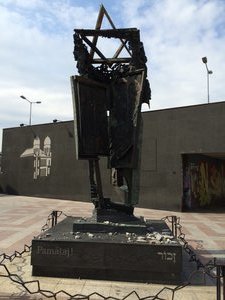Advertisement
Published: December 29th 2015

 Holocaust memorial in Bratislava
Holocaust memorial in Bratislava
Fresco of the Old Synagogue is visible on the left side of the flyover - see detailed picture of fresco.We arrived in Bratislava and after a hearty breakfast we got off the boat to visit the synagogue and other sights. We boarded trams for a tour of the city. We learned that before WWII Bratislava had been the biggest Jewish community in Slovakia. The Slovakian government paid the Germans the sum of 1000 Reichs per Jew to exterminate them. The Catholic priest who lead this and drank tea with Hitler was hanged at the end of the War.
Independence has happened twice in Slovakia’s history. In 1918 Slovakia split from the Austro-Hungarian Empire and then again in 1993 Slovakia split from the Czech Republic. In 1948 it was taken over by the Soviet Union and in 1968 the Soviet army invaded against Alexander Dubcec. However, as an independent nation in 2002 Slovakia joined NATO and in 2004 the EEC. In 2009 it became part of the Shengen agreement on borders and joined the Euro.
Our first stop was the castle (scroll down to see pictures below). This was built by Marie Therese Habsbourg (daughter of Marie Antoinette who married Louis XVI of France and who were executed in 1793). We didn’t enter the castle just admired the view.

 Fresco of the Old Synagogue in Bratislava - which was razed and replaced by this Flyover
Fresco of the Old Synagogue in Bratislava - which was razed and replaced by this Flyover
The fresco appears behind the Holocaust memorial - see left side of flyover in that picture.We could see Austria and Hungary to the north and south. Then on to Donkey Hill to see the location of the Parliament.
Next stop the Holocaust memorial. There we heard the personal story of our guide. Our guide’s father was Jewish and had a very Jewish name. In order to avoid being taken away by the Gestapo he changed his name. However, somebody gave him away and he was taken to Saxehausen. He had married a Catholic lady. She was released after three days. At the end of the war he came back but his brother had died. As a way of thanking the snitch, the Gestapo gave the the family bakery to him.
Every year during Chanukah the menorah is lit at the Holocaust memorial. The memorial lies at the site of a synagogue which was demolished in order to build a flyover. Today that old synagogue survives only in a painting on a fresco there. The synagogue was situated amongst a number of families' private palaces which were also demolished.
Jewish Bratislava is very small. Before the War there were about 15,000 Jews but now there are only between 600 and 650 out of
a total of about 3000 in Slovakia.
From there we went to, what for me was the highlight of the cruise – the memorial of the Chatam Sofer (Moses Sofer). I had just finished reading a biography of the Chatam Sofer and he was the Rabbi of Pressburg which, I didn’t know when reading, was the old name of Bratislava. We went down to the vault in which he is said to have been buried along with other important personages. He had died in 1847. When a new road had been laid in 1942 most of the bodies in the cemetery were reburied elsewhere. The graves of the Chatam Sofer and a few important persons were retained. The graves were completely ignored and became very run down. After 1989 an international corporation raised funds to preserve the graves and today the public are able to visit the graves.
Then on to the bus again and to the Jewish Museum. Here we saw items in regular usage in a bygone age. Things like sifrei torah, silverware and items used for the Holy days and Shabbat. In addition there were items referring to the Holocaust. There is no Holocaust education
in Bratislava but the Jewish cultural organisation has produced a text book which is in use in schools.
Then on to the synagogue. The President of the shul told us that the Orthodox community is small but successful and things are peaceful for the Jews. The Jewish community was established in 1291 and the shul was built between 1923 and 1926. It was used since then except during WWII when it was used to store Jewish objects. The shul itself is used between May and October ie from Shavuout to Succot. The rest of the year services are held in the community centre. The Mechitzah is downstairs which means that men and women sit downstairs in separated sections.
If you want to be counted as part of the community then you must register as being Jewish. Membership means that one can join in cultural and social events and not necessarily religious events.
Under the rule of Henry III (1017 – 1057) a charter was drawn up which gave Jews the same rights and duties as other citizens.
(scroll down for Additional photos below if all 6 not visible here)
.
Advertisement
Tot: 0.072s; Tpl: 0.015s; cc: 10; qc: 24; dbt: 0.0467s; 1; m:domysql w:travelblog (10.17.0.13); sld: 1;
; mem: 1.1mb









